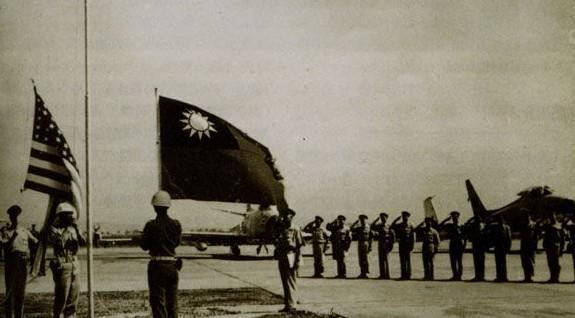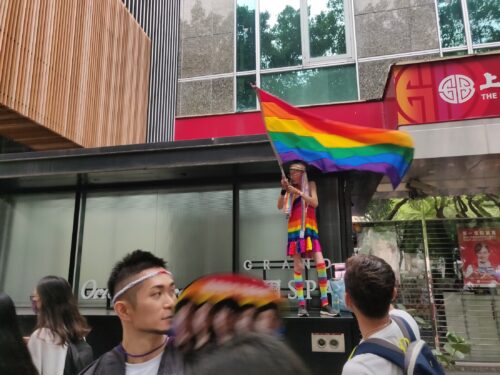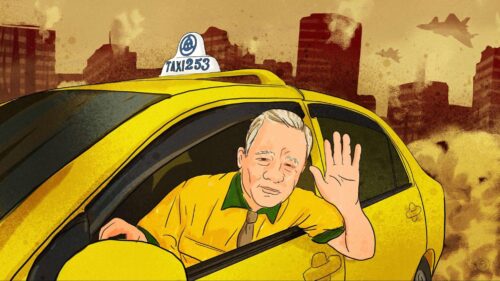This Week in China’s History: September 3, 1954
Fourteen-year-old Zheng Qingli was playing basketball on the afternoon of September 3, 1954, not far from his home in the village of Jinmencheng. The village was on the ruins of an old Ming Dynasty fortress, built in the 14th century to defend the island of Jīnmén 金門 because of the island’s strategic command of the approaches to the city of Xiamen, just a few miles to the West. Better known as Quemoy, the name derived from the local Minnan dialect, and often paired with Matsu (Mazu), the tiny island came to assume outsized importance in geopolitics thanks to two incidents in the 1950s, the first of which began that September afternoon in 1954.
Told in Michael Szonyi’s book Cold War Island, strange noises interrupted Zheng’s basketball game. “I heard the sounds of shelling,” Zheng told interviewers. “We all scrambled up onto the old town walls to watch. We could see the shells firing from the Communist guns on the coast in Xiamen…what a sight!”
But the spectacle soon turned deadly. “Suddenly there was a loud sound ‘xiuuuu.’ A shell flew right over our heads…It landed on my aunt, killing her and the child she was carrying on the spot…I ran home…All I could do was hide under my bed and pile some blankets on the bed, thinking this would protect me.”
Zheng’s aunt was one of the first casualties of what Jinmen residents called the “September 3 Artillery War,” the first of two Taiwan Strait crises (the second occurred in 1958) that have largely faded to interesting footnotes in the history of the Cold War. Yet they are worth looking back on for several reasons that would have surprised observers at the time. First, the use of nuclear weapons, and the threat of large-scale nuclear war, was much closer than people realized at the time, at least as likely as in the Cuban Missile Crisis. And second, the status of Taiwan remains unresolved nearly 70 years later. In a world where conflict among the world’s great powers seems more possible than it has for some time, reflecting on what we saw in 1954 may be important.
There is so much unusual about Taiwan’s status that we can take for granted just how odd these offshore islands are: Taiwanese territory 100 miles away from Taiwan but within firing (or swimming) range of the Chinese mainland. Just weeks after Mao proclaimed the People’s Republic on October 1, 1949, some of the last battles of the civil war took place on the coast of Fujian. Xiamen fell in just a few days of fighting, and the People’s Liberation Army (PLA) set its sights on Jinmen, launching an invasion on October 25. Contrary to expectations, though, the Communists were beaten back. Some 9,000 PLA soldiers landed on the island; within three days all of them had been killed or captured. Known as the Battle of Guningtou, after the village closest to the PLA landing, the encounter stopped the PLA momentum that might have propelled it to the conquest of Taiwan and final annihilation of the Nationalists. It also left Jinmen, just two miles offshore, in Nationalists hands.
This strange state of affairs seemed unlikely to last long. Just a few months after the Battle of Guningtou, U.S. President Truman said, “The U.S. government will not pursue a course which will lead to involvement in the civil conflict in China…Similarly, the U.S. government will not provide military aid or advice to Chinese forces on Formosa.” Without American support, there was little chance that the Communists could be prevented from taking Jinmen — or Taiwan — for long.
This soon changed dramatically. The outbreak of war on the Korean peninsula in the summer of 1950 transformed U.S. policy in Asia, shifting Japan from a vanquished foe to a would-be ally and making Taiwan a much more important asset. The Republic of China in Taiwan began pressing Washington for a formal protection treaty.
This unlikely state of affairs persisted in the summer of 1954. Emboldened by American support, the government in Taiwan positioned 40,000 troops on Jinmen, optimistically preparing to invade the mainland. Meanwhile, United States representatives arrived in Manila for the conference that would launch the Southeast Asia Treaty Organization (SEATO), a key in the evolving Cold War strategy of containment, and a move that the PRC government warned would be viewed as a hostile act.
Just five days before the Manila Conference, the shells that disrupted Zheng Qinli’s basketball game were fired on Jinmen. They were just the start of a continual bombardment that would last eight months, destroy thousands of homes, and kill hundreds of people (mainly Taiwanese citizens but several American as well). Tens of thousands of artillery shells landed on Jinmen and surrounding islands.
Historians Gordon H. Chang and He Di have documented just how close the incident brought the world to nuclear war. In their 1993 article in the American Historical Review, Chang and Di reach a chilling conclusion: “The absence of war was due more to good luck than to effective deterrence.”
The American Joint Chiefs of Staff responded to reports that Communist forces were attacking Jinmen by urging tactical nuclear strikes against the mainland. Eisenhower, in office just a few months, rejected this course of action at the time, but kept the nuclear option open.
PRC strategists saw the shelling of Jinmen as a test of American resolve. American policy took this into account. However, American strategists mistook Beijing’s limited action for acceptance of the status quo, and likewise Beijing confused American deliberateness with lukewarm support of Taiwan’s status. The result could have easily led to nuclear disaster.
Chang and He Di found that Eisenhower’s strategy was moving the U.S. and PRC toward war in two ways. The United States, though publicly equivocating, committed privately to defend the islands against an invasion, and endorsed using nuclear weapons to do so. At the same time, Washington asked Taiwan to relinquish Jinmen (and Mazu), believing they were indefensible. If Taiwan’s government agreed, the United States would enact a 500-mile blockade of the Chinese coastline opposite Taiwan to facilitate the evacuation of Jinmen.
Washington was now committed to two paths that led to war. A blockade of the sort Eisenhower proposed would have provoked a Chinese attack, and American forces, documents show, would have responded with atomic weapons. A PRC invasion of Jinmen would have led to a nuclear response as well.
Neither of these scenarios came to pass thanks, ironically, to the two adversaries: Chiang Kai-shek (蒋介石 Jiǎng Jièshí) and Zhōu Ēnlái 周恩来.
Chiang refused to relinquish the islands as Washington asked. Doing this prevented the blockade, but all parties now seemed to be careening toward war. In December, the U.S. and Taiwan formalized a defense treaty that publicly obligated the United States to defend Taiwan (though not Jinmen). By January, both the Nationalists and Communists were attacking the other’s territory with airstrikes, with the Communists launching another invasion of an offshore island, Dachen, several hundred miles from Taiwan.
As spring came, the crisis continued to escalate. Eisenhower made clear that nuclear weapons “were interchangeable with the conventional weapons” that might be used. Vice President Richard Nixon asserted that nuclear weapons “will be used against the targets of any aggressive force.” American General Curtis LeMay — architect of the massive strategic bombing campaign against North Vietnam a decade later — made plans to drop nuclear bombs on several dozen Chinese targets from bombers based at Guam.
By the end of March 1955, the U.S. side seemed desperate to avoid war, but despondent that it could do so. A last-ditch proposal to Chiang offered to blockade the Chinese coast and lay mines — in PRC territorial waters — if Chiang would abandon Jinmen.
This proposal was never made because in April, Zhou Enlai — speaking in Bandung, Indonesia, at the conference of non-aligned nations — offered to open negotiations to defuse the crisis, saying that “the Chinese people are friendly to the American people.” The United States jumped at the chance and work toward a ceasefire began. The crisis petered out (to be revived in 1958).
It’s unlikely that the actors in the 1950s would have expected that, 70 years later, the situation in Taiwan would be largely the same. The passage of time has made the situation seem normal, but the departure from norms in recent years has again highlighted what a unique, unpredictable, and inherently dangerous situation exists in the unresolved end-game of the Chinese Civil War. A look back at 1954 may remind us that decisions made in the past were not the only ones that might have been made, and that also — as we find U.S.-PRC relations at their lowest point perhaps since those two strait crises — we should pause to consider the consequences of the decisions we face today.
This Week in China’s History is a weekly column.






